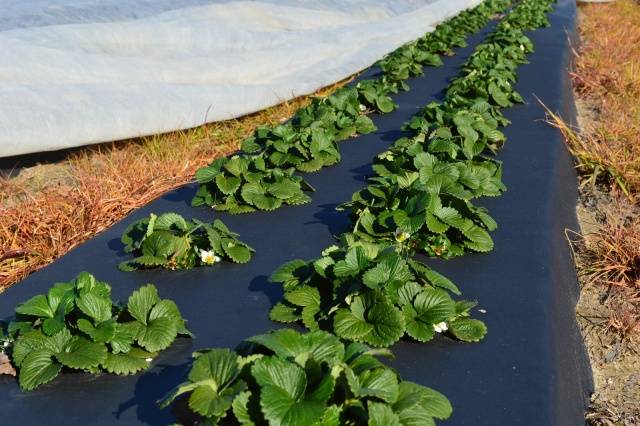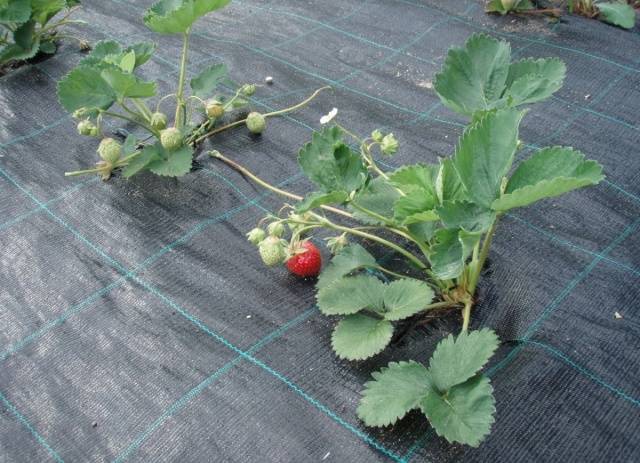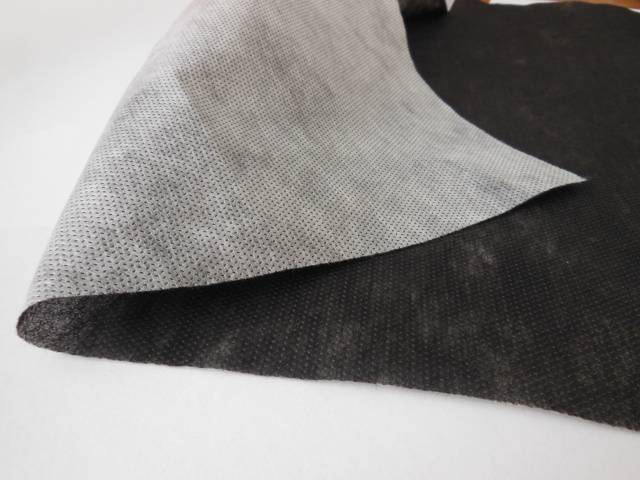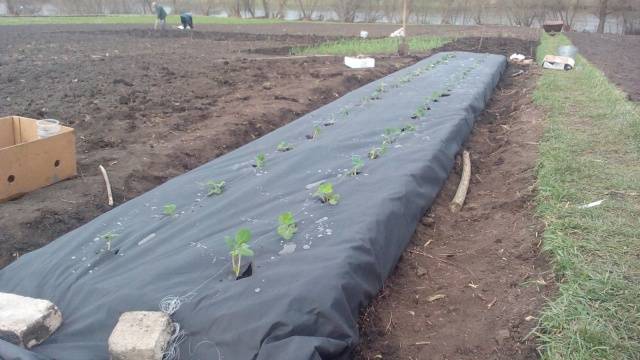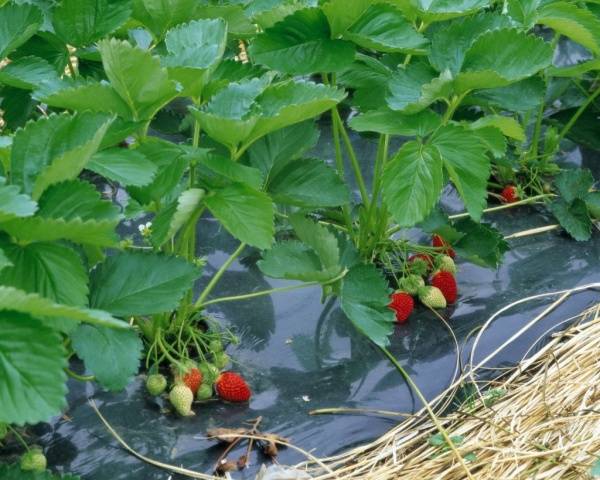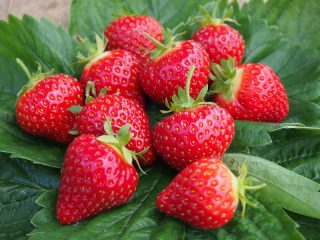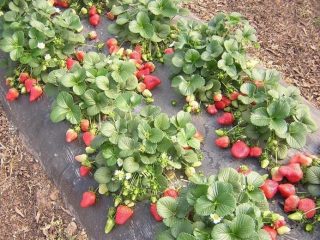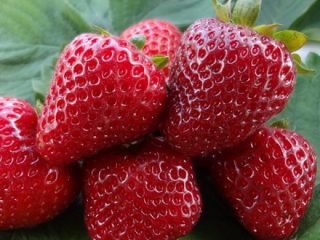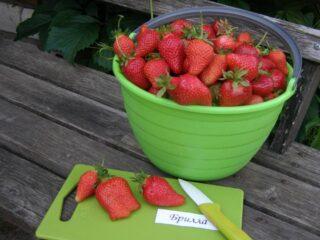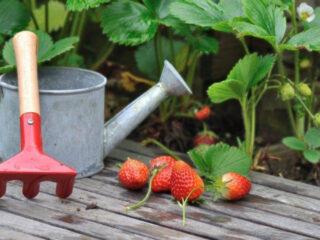Content
Modern methods of growing strawberries provide good yields at minimal cost. One of them is the use of artificial materials to cover beds. Covering material for strawberries can be purchased at specialized gardening stores.
The result of arranging such beds can be seen in the photo:
Advantages and disadvantages of growing strawberries under covering material
Planting strawberries under covering material has the following advantages:
- the necessary microclimate is created;
- the soil under the film does not dry out;
- the coating attracts earthworms, which loosen and fertilize the soil;
- The rhizome of plants develops more actively;
- black film does not allow sunlight to pass through, therefore protects strawberries from weed;
- the plant tendrils will not be able to gain a foothold in the soil, so when processing the plantings it is enough to trim them;
- the ripening process of berries is accelerated;
- By mulching strawberries, the fruits remain clean because they do not come into contact with the ground;
- pests cannot get onto the leaves from the soil;
- the soil under the film warms up faster and retains heat for a long time;
- strawberries tolerate spring frosts more easily;
- The winter hardiness of planted plants increases.
The main disadvantage of the method is the need to arrange an irrigation system. For large planting areas, drip irrigation of strawberries is installed. To do this, you need to lay a pipeline and supply water to each bush. Drip irrigation ensures a uniform supply of moisture to the soil.
Another disadvantage is that planting strawberries under black covering material leads to excessive heating of the plants. Dark shades attract the sun's rays. Under the scorching rays of the sun, the yield of plantings may decrease.
Selection of seedlings
Any variety is suitable for planting strawberries under covering material. It is best to choose tall plants. There are no other restrictions when selecting seedlings.
Seedlings are purchased from reliable producers, which avoids the spread of diseases and insects on the site. Seedlings must be strong and healthy.
If the seedlings are prepared independently, then you need to select several mother bushes. During the season, the flower stalks on them are cut off to produce good mustaches. Vigorous strawberry bushes can be propagated by dividing them.
Before planting, seedlings are treated with iodine or garlic solution. Before moving plants into the ground, water them thoroughly.
Selection of covering material
The following types of covering material are suitable for planting strawberries:
- Spunbel is a non-woven fabric made from polypropylene for mulching strawberries and other crops. It is durable and light, moisture-permeable. The service life of spanbel is 4 years.
- Spunbond is a fabric made from molten polymer fibers. The spunbond coating is durable, strong and wear-resistant.The material provides air exchange, is safe for plants, and can protect them from spring cold snaps and temperature changes. Black spunbond has a density of 50 and 60 g/m2 and serves for 4 years.
- Agrospan is a non-woven material that can protect plant roots from frost, stabilize watering and air exchange. Agrospan has a homogeneous structure and does not require replacement for 4 years.
- Lutrasil is a covering material that does not get wet and does not create a greenhouse effect in strawberries. Compared to spunbond, it is less resistant to sun exposure.
- Agrofibre is a material that allows water and air to pass through well, but creates an obstacle to sunlight.
Which material to choose depends on its cost and characteristics. Most materials have similar characteristics. The best option is agrofibre, which provides reliable cover for the beds. Its cost is slightly higher compared to other materials. It is not recommended to use polyethylene film, since it does not provide air and moisture exchange.
Soil preparation
Strawberries prefer light soil, chernozem, loamy or sandy loam. On loamy soil, plants receive maximum nutrients with high air permeability.
Sandy soil retains moisture less well, resulting in nutrients going into the deeper layers of the soil. The addition of peat, organic fertilizers and white clay will help improve its properties. As a result, moisture will evaporate more slowly from the soil surface.
On clay soils, the root system of plants develops slowly and does not receive the necessary nutrients.Therefore, strawberries under covering material are fertilized with ash, compost or sand.
When choosing a place for a garden bed, follow certain recommendations:
- preference is given to elevated locations;
- the beds should be well lit and protected from the wind;
- You can plant strawberries on covering material in beds where garlic, carrots, onions, legumes and cereals previously grew;
- strawberries do not need to be planted after cabbage, cucumbers, peppers, potatoes;
- beds should not be flooded in the spring during floods or rains.
After choosing a place for planting, dig up the soil, remove weeds and plant debris. Fertilizer (compost or humus) must be added. Then the soil is watered and the formation of beds begins.
Small ditches are dug around the perimeter of the beds to strengthen the material. The soil needs to be leveled with a rake.
Boarding order
Victoria seedlings take root well in warm weather. For planting, choose autumn or spring. The preferred option is to arrange beds under covering material in the fall.
After preparing the soil, you need to secure the covering material. The following available tools will help solve the problem of how to plant strawberries under black covering material:
- hairpins;
- wooden boards;
- stones;
- bricks.
The author of the video covered the beds with film using boards:
It is also possible to dig the edges of the film with earth. Covering material is attached around the perimeter of the bed. The irrigation system is pre-installed.
After covering the beds, cross-shaped cuts are made in the film. About 30 cm is left between the bushes. Rows with strawberries are placed at a distance of 40 cm. Plants can be planted in the resulting holes.
How to plant strawberries on covering material, the following tips will help:
- the material should tightly cover the bushes;
- a film that is too thin may tear when weeds appear;
- if you make holes before laying the material, then difficulties will arise with securing it;
- it is allowed to overlap the film (the strips overlap each other by at least 15 cm);
- in regions with arid climates, the film can be additionally covered with straw.
Further care
After planting under covering material, strawberries do not require special care. Plants require watering and fertilization. Liquid solutions are used for feeding.
Growing strawberries under black covering material reduces the amount of watering and completely eliminates the need for weeding and loosening. Twice per season, plants are treated against diseases and pests.
Chemicals are used for processing to destroy harmful spores and insects. Additionally, plants are treated with iodine solution (20 drops per 10 liters of water).
If the planting area is small, then watering is done manually for each bush. It is not recommended to water plants with cold water.
In the first year after planting, it is better to cut off the flower stalks so that the plants can take root in a new place. A month after the strawberries are transferred to a permanent place under the bushes, vermicompost is added. Repeated application of fertilizers is carried out after two weeks.
After harvesting, it is better to trim off the dried leaves. Many gardeners practice complete pruning of strawberries.In this case, the plants need a long period to restore their green mass.
Conclusion
Growing under covering material greatly simplifies caring for strawberries. Mulching protects plants from temperature fluctuations, ensures air exchange and moisture supply. To cover the beds, special materials with the necessary qualities are used. The material protects the plantings from frost, retains heat and accelerates the ripening of berries. This coating requires replacement every 4 years.
